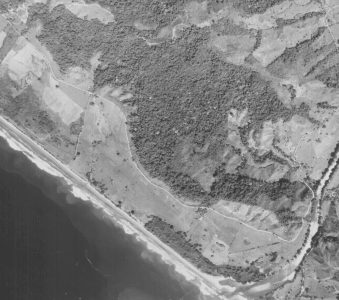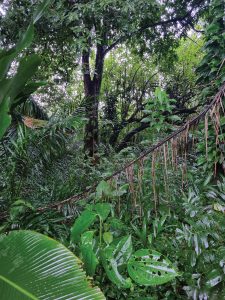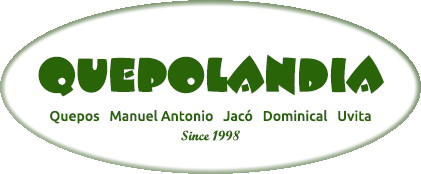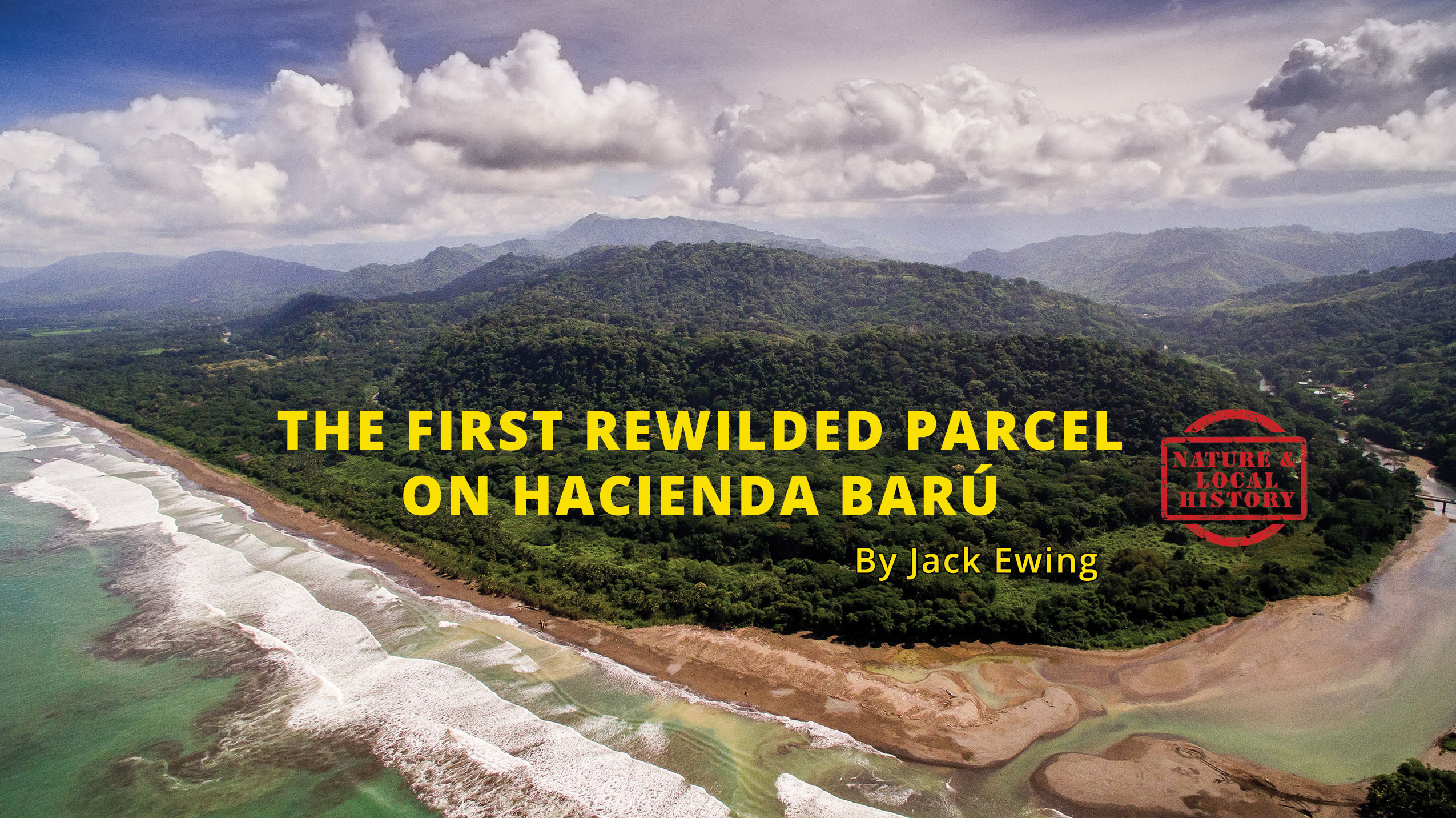The First Rewilded Parcel on Hacienda Barú
Memo’s Cornfield
When I began working at Hacienda Barú in 1972, the owners were a group of investors from North America. They had recently purchased the hacienda, and according to the sale contract the property was supposed to be free of squatters. That turned out to be false. About three months before the closing, a guy named Memo had felled seven hectares of primary forest on the upper slopes of the hacienda, built a one-room, dirt-floored shack where he lived with his wife and four kids, and planted corn on the land. He claimed it as his own.

My first job was to evict Memo. I didn’t have any idea how to carry out that task and was more than a little apprehensive. I knew that the law was on our side. The land was titled in our name, and Memo had only been there a short time. I called our lawyer in San Jose, but he was a city slicker and had less idea than I did about how to deal with the situation.
“For me to file charges and carry out a legal eviction would take several years and cost a fortune,” he informed me, “and I don’t think your employers would be too happy about that. Out in the boondocks people do things differently. Ask your employees. Ask your neighbors. They know how campesinos deal with these situations.”
Tonio, the head cowboy at Hacienda Barú suggested talking to the policeman in Dominical. I had already met Don Antonio. I liked him and liked the idea of consulting with him. I jumped on my horse and headed for Dominical. I found him in his office near Bar and Restaurant Miramar (today known as Roca Verde) and explained my problem.
“I think all we need is to get Memo here and talk this out,” he commented calmly. “Talking is a great way to solve problems like this.” Don Antonio wrote a summons for Memo to appear at the police office at 3:00 pm that afternoon, gave it to Tonio, and said: “Take this to Memo. He can’t read so you’ll have to tell him it says to be here at three.”
I was already there when a small, skinny, barefoot man appeared in the doorway. I assumed it was Memo. He was all fired up: “I know what you gringos are up to. You’re gonna take away my farm. I got 10 manzanas of corn. I worked my butt off chopping down those trees and planting that corn. (Memo didn’t understand hectares. In those days he, and most other campesinos, used a measurement of area called a manzana. One manzana is equal to 7/10 of a hectare or 1.72 acres.)
Don Antonio interrupted Memo. “Hey man. You’re gittin all worked up. Tranquilo! We’re here to talk. We know you worked hard clearing that land and planting that corn. What do you figure your work is worth? Maybe Don Jack would be willing to pay you something.”
Memo’s face lit up. “I’d need at least 500 colones,” he blurted out. (In those days 500 colones were worth $58.34.)
Don Antonio saw me smile. “Whatta ya say Don Jack? Pay Memo 500 colones for his corn, and he’ll leave the land, the rancho, and the corn and go somewhere else.
“I’ll give him 250 colones right now, and the rest when he leaves.”
“Sounds like a good deal to me,” smiled Don Antonio.
Memo agreed. Don Antonio typed up a short note with the terms of the agreement, I signed, Memo put his X on the line, I gave him half the money, and everyone went home happy. Two days later Memo came by the house for the 250-colon balance. I sent Tonio up to make sure they were all gone and had taken all their belongings. He soon returned saying they had, I paid Memo, and that was the last we saw of him.

I told the Hacienda Barú workers they could have the corn if they wanted it, but while they were waiting for it to ripen the monkeys ate it all. That seven-hectare parcel was taken over by Mother Nature who returned the land to its natural state. In other words, She rewilded it. For the first 25 years the area was dominated by a fast-growing species of tree called the gallinazo (Schizolobium parahyba). The faster a tree grows, the younger it is when it dies and falls over. These gallinazos began toppling at about 20 years. New species of trees sprouted and filled the spaces where the gallinazos had been. Today more than two dozen tree species cover the parcel and lots of undergrowth. It looks just like the rest of the jungle. Memo’s cornfield was the first part of Hacienda Barú to be rewilded. Little by little and parcel by parcel 96% of the pastureland was rewilded. Today the hacienda is an officially recognized nature reserve called Hacienda Barú National Wildlife Refuge.
One day in the early 2000s I was driving to San Isidro and saw a heavyset man with a fancy cowboy hat, boots, and a big silver belt buckle standing at a bus stop. He had missed his bus. I felt sorry for him and gave him a ride. He told me all about his farm near Paquarito where he raised cattle. I told him I was from Hacienda Barú.
“Oh my God. You must be Jack. I thought you looked familiar. I’m Memo. Don’t you remember me?”
“If you’re the Memo I think you are, you look a lot different than you did last time I saw you,” I exclaimed.
Memo went on to tell me the story of their life after being evicted. When they left Hacienda Barú they had gone to the Osa Peninsula where he and his two sons mined gold. They had a huge stroke of luck and found an enormous six-and-a-half-pound nugget. I figured it would have been worth about $75,000 at the time. Memo showed me a Polaroid photo of him with his two sons, each with a big cowboy hat, a pair of fancy boots, and a revolver strapped to his hip. I hope he bought something nice for his wife and daughters too. I was pleased to see that he had been smart enough to invest most of the money in the farm and cattle. Memo had come a long way since I first met him.
I wish I had a copy of that photo.
Jack Ewing was born and educated in Colorado. In 1970 he and his wife Diane moved to the jungles of Costa Rica where they raised two children, Natalie and Chris. A newfound fascination with the rainforest was responsible for his transformation from cattle rancher into environmentalist and naturalist. His many years of living in the rainforest have rendered a multitude of personal experiences, many of which are recounted in his published collections of essays, Monkeys are Made of Chocolate & Where Jaguars & Tapirs Once Roamed. His latest book is, Monkeys are Made of Mangos.

